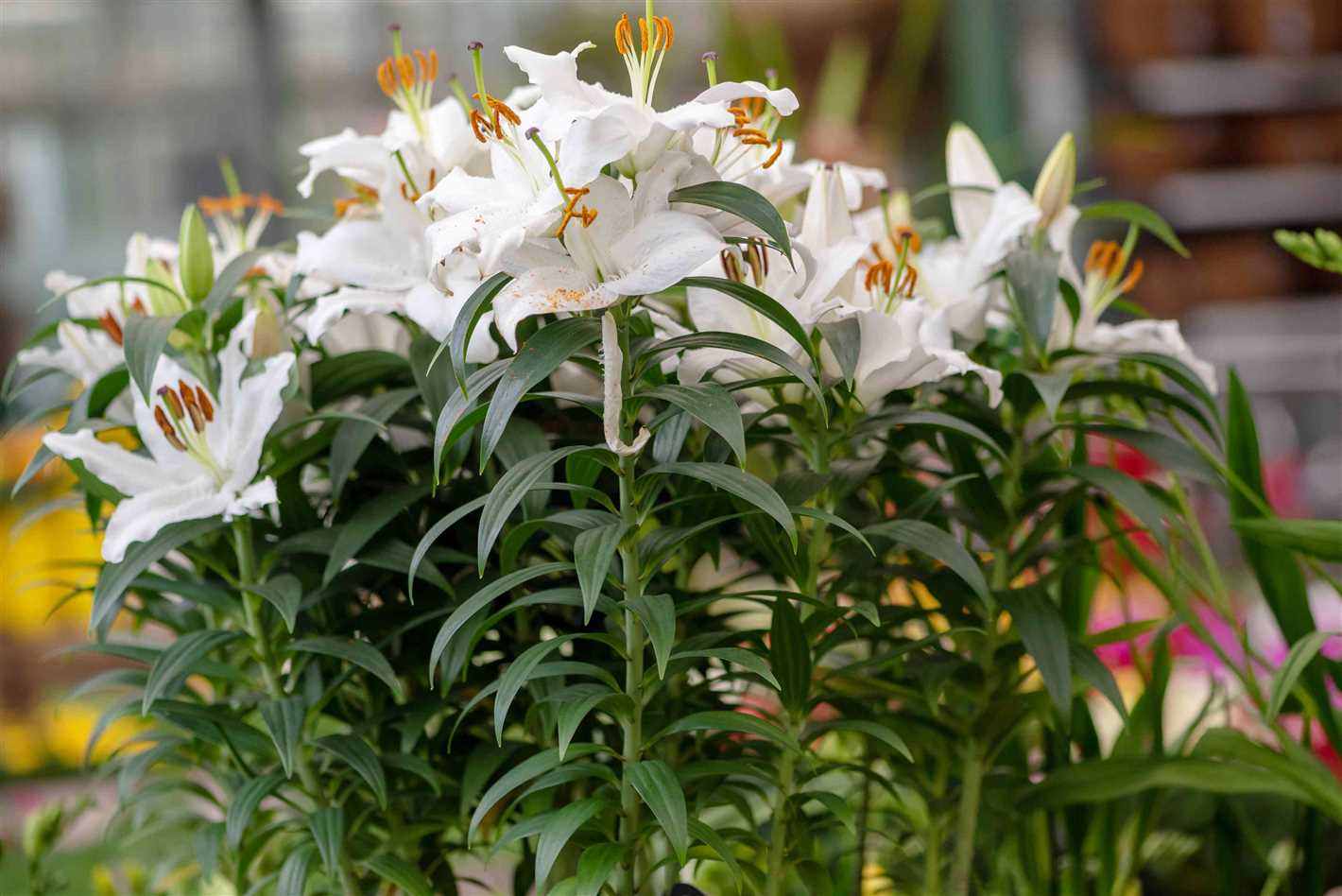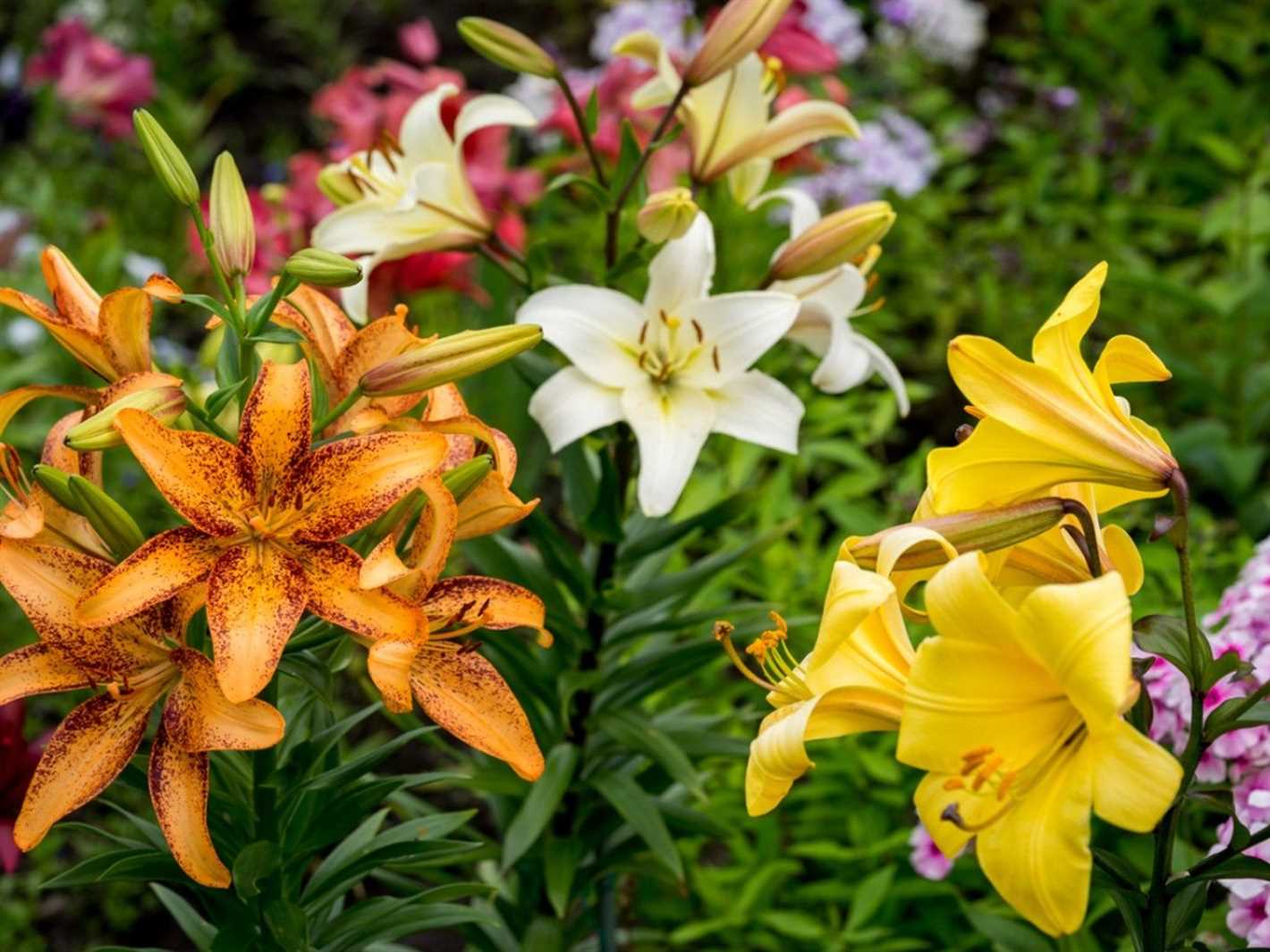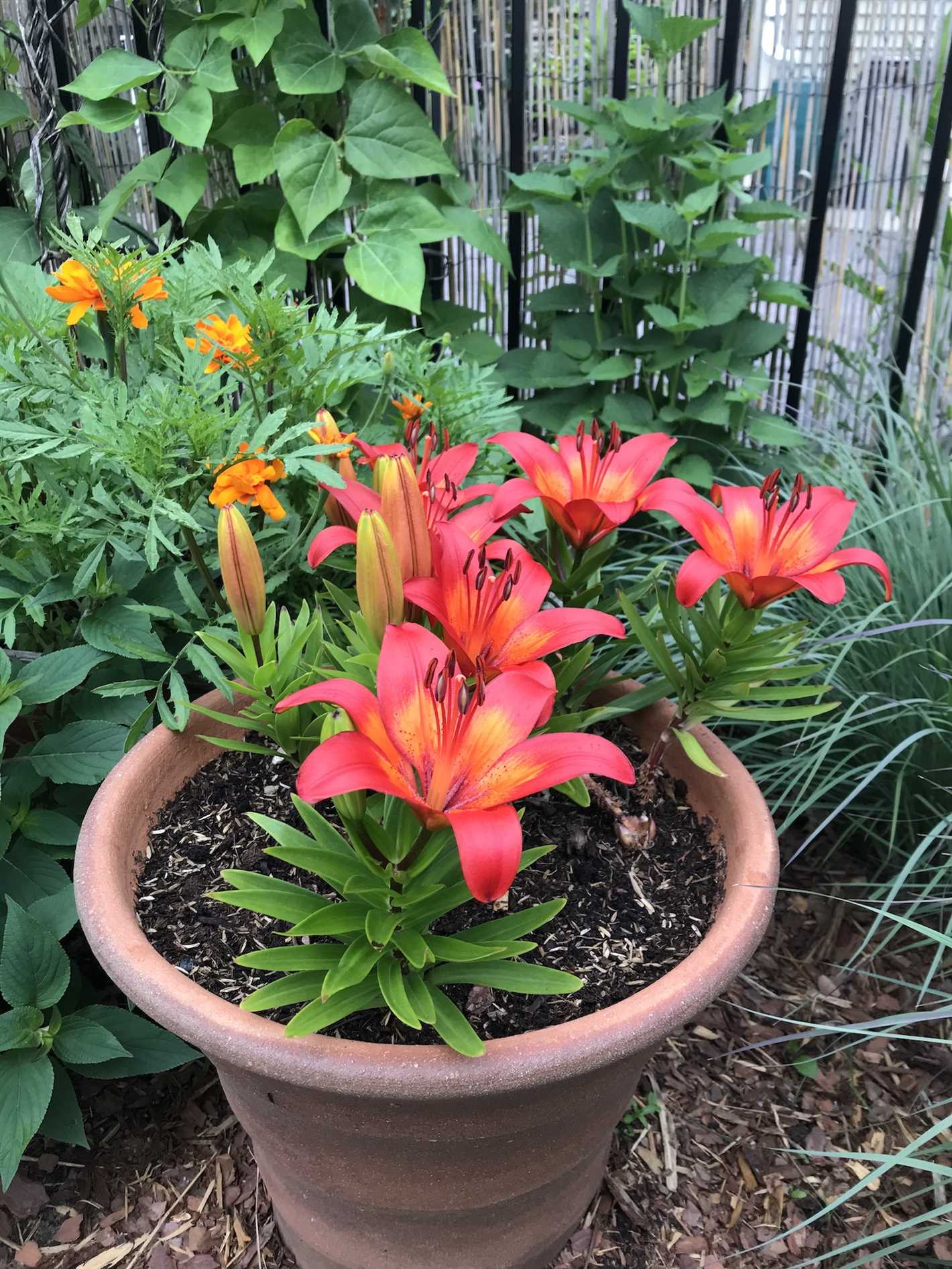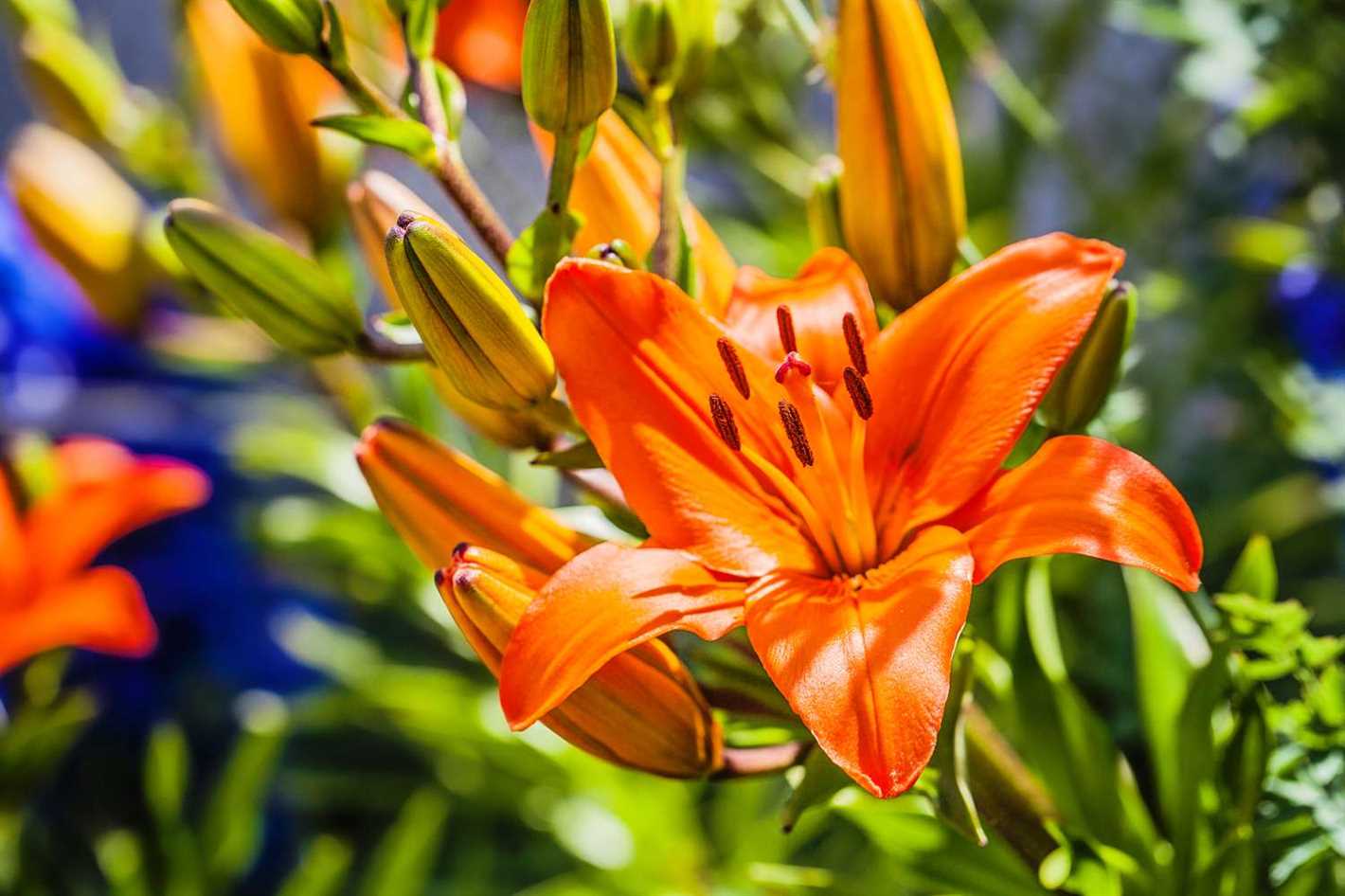- Growing Lilies in Your Garden
- 1. Selecting the Right Variety
- 2. Choosing a Suitable Location
- 3. Preparing the Soil
- 4. Planting the Bulbs
- 5. Watering and Mulching
- 6. Supporting and Staking
- 7. Fertilizing Regularly
- Choose the Right Location
- Provide Adequate Sunlight
- Prepare the Soil Properly
- 1. Choose the Right Location
- 2. Clear the Area
- 3. Test the Soil
- 4. Amend the Soil
- 5. Loosen the Soil
- 6. Add Mulch
- 7. Test the Drainage
- 8. Maintain Proper Moisture Levels
- Planting and Watering Lilies
- 1. Choosing the Right Location
- 2. Preparing the Soil
- 3. Planting Lilies
- 4. Watering Techniques
- 5. Mulching for Moisture Retention
- Protect Lilies from Pests and Diseases
- 1. Inspect your lilies regularly
- 2. Remove weeds and debris
- 3. Provide proper spacing
- 4. Mulch your lily beds
- 5. Use natural pest control methods
- 6. Water lilies carefully
- 7. Monitor for common lily pests
- 8. Follow good hygiene practices
- 9. Choose disease-resistant lily varieties
- Proper Fertilization Techniques
- 1. Choose the right fertilizer
- 2. Apply at the right time
- 3. Follow the instructions
- 4. Apply evenly
- 5. Water after fertilization
- 6. Repeat as needed
- Regular Maintenance and Deadheading
- Deadheading
- Watering
- Fertilizing
- Pest and Disease Control
- Summary
- Dividing and Transplanting Lilies
- Timing
- Preparing the Lily Plant
- Dividing the Bulbs
- Transplanting
- Aftercare
- Questions and Answers:
- How often should I water my lilies?
- What is the best location to plant lilies?
- When is the best time to plant lilies?
- Do lilies require any special soil conditions?
- How do I prevent lilies from being attacked by pests?
- Should I deadhead my lilies?
- Videos: Peace Lily NOT Blooming? DO THESE & Get GUARANTEED Result!
Lilies are stunning flowers that add beauty and elegance to any garden. Known for their vibrant colors and captivating fragrance, lilies are a popular choice among gardeners. However, growing and caring for lilies can be a bit tricky, especially for beginners. In this article, we will provide you with essential tips for caring for lilies in your garden.
Choosing the right location: Lilies thrive in well-drained soil and require a minimum of six hours of sunlight per day. It is best to choose a location that offers partial shade in the afternoon to protect the delicate flowers from scorching sun. Ensure that the soil is rich in organic matter and has good drainage to prevent waterlogging.
Planting and spacing: When planting lily bulbs, make sure to dig a hole that is three times deeper than the bulb’s height. Place the bulb in the hole with the pointed end facing upwards, and cover it with soil. It is important to space the bulbs at least a foot apart to allow air circulation and prevent overcrowding.
Watering and fertilizing: Lilies require regular watering, especially during hot summer months. However, it is important not to overwater them as excessive moisture can lead to root rot. Water the plants deeply once or twice a week, providing enough water to soak the root system. Additionally, lilies benefit from regular feeding. Apply a balanced fertilizer in the early spring and again after the flowers have bloomed to promote healthy growth.
Maintenance and pest control: To keep lilies healthy and blooming, it is important to remove any dead or wilted flowers. This will prevent the plant from wasting energy on seed production and encourage continuous blooming. Additionally, lilies are susceptible to pests such as aphids and lily beetles. Regularly inspect the plants for any signs of infestation and take appropriate measures to control the pests.
In conclusion, lilies are beautiful flowers that require specific care to thrive in the garden. By choosing the right location, planting and spacing the bulbs correctly, providing adequate water and fertilizer, and practicing regular maintenance, you can enjoy the beauty of lilies in your garden year after year.
Growing Lilies in Your Garden
Adding lilies to your garden can bring beauty and elegance to your outdoor space. With their vibrant colors and captivating fragrance, lilies are a popular choice among garden enthusiasts. Here are some essential tips for growing lilies in your garden:
1. Selecting the Right Variety
There are different types of lilies available, each with its own unique characteristics. Before planting, consider the size, color, and blooming time of the lilies to create a visually appealing garden. Some popular varieties include Asiatic lilies, Oriental lilies, and Trumpet lilies.
2. Choosing a Suitable Location
Lilies thrive in well-draining soil and require at least six hours of direct sunlight daily. Choose a location in your garden that receives ample sunlight and has soil that is rich in organic matter. Well-drained soil will help prevent rot and ensure the proper growth of the lilies.
3. Preparing the Soil
Before planting lilies, prepare the soil by removing any weeds or grass and loosening it with a garden fork. Add compost or well-rotted manure to improve the soil’s fertility and drainage. Ensure that the soil pH is slightly acidic to neutral for optimal growth.
4. Planting the Bulbs
Plant lily bulbs in the early spring or fall, depending on the variety. The planting depth should be about three times the size of the bulb. Space the bulbs apart to allow for proper growth and air circulation. Gently firm the soil around the bulbs and water them thoroughly.
5. Watering and Mulching
Keep the soil consistently moist but not waterlogged to promote healthy growth. Water the lilies deeply once a week, or more frequently during dry spells. Applying a layer of organic mulch around the plants will help retain moisture and suppress weed growth.
6. Supporting and Staking
Tall varieties of lilies may require support to prevent them from bending or toppling over. Use stakes or cages to support the plants as they grow. Install these supports early in the season to avoid damaging the bulbs or roots.
7. Fertilizing Regularly
Feed lilies with a balanced fertilizer or slow-release granules in early spring and again after blooming. Follow the package instructions for the correct dosage and apply the fertilizer evenly around the base of the plants. This will provide essential nutrients to the lilies and promote healthy growth.
By following these tips, you can successfully grow lilies in your garden and enjoy their stunning blooms year after year. Remember to monitor the plants for signs of pests or diseases, and take appropriate action if necessary. With proper care, lilies can be a highlight of your garden and create a beautiful focal point.
Choose the Right Location
When planting lilies in your garden, it is important to choose the right location to ensure their optimal growth and blooming. Here are some factors to consider when selecting the spot:
- Sunlight: Most lilies prefer full sunlight, which means they need at least 6-8 hours of direct sunlight each day. Choose a location that receives ample sunlight throughout the day.
- Soil Quality: Lilies thrive in well-drained soil that is rich in organic matter. They prefer slightly acidic to neutral soil with a pH level between 6.0 and 7.0. Test your soil’s pH and amend it if necessary.
- Moisture: While lilies need regular watering, they don’t like to sit in soggy soil. Make sure the chosen spot has good drainage to prevent waterlogging. Avoid areas that are prone to flooding or have poor drainage.
- Protection from Wind: Lilies have delicate stems that can easily be damaged by strong winds. Choose a location that provides some protection from strong gusts. Planting them near a fence or wall can help break the wind.
- Space: Lilies require adequate space to grow and spread. Make sure there is enough room for the specific variety you are planting. Overcrowding can lead to poor airflow, increased risk of disease, and reduced bloom production.
By considering these factors and selecting the right location for your lilies, you can ensure they receive the optimal conditions for growth, resulting in healthy plants and beautiful blooms.
Provide Adequate Sunlight
Lilies are sun-loving plants that thrive in bright and sunny locations. In order for your lilies to grow and bloom to their full potential, it is important to provide them with adequate sunlight.
A minimum of 6-8 hours of direct sunlight per day is recommended for most lily varieties. If your garden or outdoor space does not receive enough sunlight, consider planting your lilies in pots and placing them in a sunnier spot or using artificial lighting to supplement the natural sunlight.
When selecting a location for your lilies, choose an area that is not shaded by trees or buildings for most of the day. Lilies also prefer a location that is sheltered from strong winds, as this can damage the delicate flower petals.
It is important to note that while lilies require ample sunlight, they can also be sensitive to intense heat. If you live in a region with extremely hot summers, providing some shade during the hottest parts of the day can help prevent sunburn and protect the plants from heat stress.
By ensuring your lilies receive adequate sunlight, you will be rewarded with healthy plants that produce beautiful flowers year after year.
Prepare the Soil Properly
Properly preparing the soil is essential for successful lily cultivation in your garden. Lilies prefer well-draining soil that is rich in organic matter. Here are some tips to help you prepare the soil before planting your lilies:
1. Choose the Right Location
Select a location for planting your lilies that receives full sun or partial shade. Lilies thrive in areas with at least 6 hours of direct sunlight each day. Additionally, make sure the soil in the chosen location is well-draining to prevent waterlogging, which can cause root rot.
2. Clear the Area
Clear the area of any weeds, grass, or debris that may impede the growth of your lilies. Use a rake or garden hoe to remove these obstacles and create a clean planting space.
3. Test the Soil
Before adding any amendments, it is important to test the soil to determine its pH level. Lilies prefer slightly acidic to neutral soil with a pH range of 5.8 to 7.0. You can use a home soil testing kit or send a sample to a local agricultural extension office for analysis.
4. Amend the Soil

If the soil pH is too low or too high, you will need to amend the soil to make it suitable for lilies. Adding lime can raise the pH, while sulfur can lower it. Additionally, incorporating organic matter such as compost or well-rotted manure can improve the soil’s fertility and structure.
5. Loosen the Soil
Using a garden tiller or a digging fork, loosen the soil to a depth of at least 12 inches. This will improve soil aeration and drainage, allowing the lilies’ roots to grow more easily.
6. Add Mulch

After planting your lilies, cover the soil with a layer of organic mulch. This will help conserve moisture, suppress weed growth, and regulate soil temperature. Apply a 2 to 4-inch layer of mulch around the lilies, keeping it a few inches away from the plant’s stems.
7. Test the Drainage

Water the soil thoroughly and observe how quickly the water drains. If the water pools or takes too long to drain, you may need to further improve the drainage by adding sand or perlite to the soil.
8. Maintain Proper Moisture Levels
While lilies require well-draining soil, they also need consistent moisture to thrive. Monitor the soil moisture regularly and water the lilies when the top 1-2 inches of soil feels dry. Be careful not to overwater, as lilies do not tolerate waterlogged conditions.
By following these steps to prepare the soil properly, you will create an ideal growing environment for your lilies. This will help promote healthy growth, abundant blooms, and overall success in your garden.
Planting and Watering Lilies
Proper planting and watering techniques are crucial for the successful growth and blooming of lilies in your garden. Follow these essential tips to ensure healthy and vibrant lilies:
1. Choosing the Right Location
Lilies thrive in areas with full sun or partial shade. Select a location in your garden that receives at least 6 hours of direct sunlight each day. Make sure the soil is well-drained to prevent waterlogging, as lilies do not tolerate overly wet conditions.
2. Preparing the Soil
Before planting lilies, prepare the soil by removing any weeds, rocks, or debris. Loosen the soil to a depth of 12-15 inches and mix in organic matter, such as compost or well-rotted manure, to improve its fertility and drainage.
3. Planting Lilies
When planting lilies, follow these steps:
- Dig a hole that is approximately two times the size of the bulb and deep enough to accommodate the bulb and its roots.
- Place the bulb in the hole with the pointed end facing up. Ensure that the bulb is positioned at a depth equal to three times its height.
- Backfill the hole with soil, gently firming it around the bulb to remove any air pockets.
4. Watering Techniques
Proper watering is essential for the health of lilies. Follow these watering techniques:
- Water newly planted lilies immediately after planting to settle the soil around the bulbs.
- Water lilies regularly, providing 1 inch of water per week, evenly moistening the soil.
- Water deeply, ensuring that the water reaches the root zone. Avoid wetting the foliage, as this can lead to diseases.
- Monitor the soil moisture levels and adjust the watering frequency based on the weather conditions. Lilies prefer evenly moist soil but do not tolerate waterlogged conditions.
5. Mulching for Moisture Retention
To help retain soil moisture and suppress weed growth, apply a layer of organic mulch, such as wood chips or straw, around the base of lilies. Mulching also helps regulate soil temperature and protects the bulbs during winter.
By following these planting and watering tips, you can ensure the successful growth and blooming of lilies in your garden. With proper care, your lilies will reward you with their stunning flowers year after year.
Protect Lilies from Pests and Diseases
Keeping your lilies healthy and free from pests and diseases is essential to their overall well-being. Here are some tips to protect your lilies:
1. Inspect your lilies regularly
Regularly inspect your lilies for any signs of pests or diseases. Look for chewed leaves, holes, discoloration, or any unusual growth. Detecting problems early on can help prevent further damage.
2. Remove weeds and debris

Weeds and debris can attract pests and provide a breeding ground for diseases. Remove any weeds or fallen leaves around your lilies to maintain a clean and pest-free environment.
3. Provide proper spacing
Avoid planting your lilies too close together. Crowded plants can create favorable conditions for diseases and make it easier for pests to spread. Provide adequate spacing between each lily plant to promote air circulation and reduce the risk of contamination.
4. Mulch your lily beds
Applying a layer of organic mulch around your lilies can help insulate the soil, retain moisture, and deter pests. Use materials like straw, wood chips, or shredded leaves to create a protective barrier around your lily beds.
5. Use natural pest control methods
Avoid using harsh chemicals that can harm beneficial insects and pollinators. Instead, opt for natural methods to control pests. You can introduce beneficial insects like ladybugs or lacewings, use organic insecticidal soaps, or try homemade remedies like garlic or chili pepper sprays.
6. Water lilies carefully
When watering your lilies, avoid wetting the foliage excessively. Wet leaves can promote the growth of fungal diseases. Instead, water at the base of the plant to keep the leaves dry and minimize the risk of infections.
7. Monitor for common lily pests
Keep an eye out for common lily pests such as aphids, slugs, snails, and lily beetles. If you notice any of these pests, take immediate action to control their population. You can handpick them, use traps, or apply natural insecticides targeted for specific pests.
8. Follow good hygiene practices
Practicing good hygiene can go a long way in preventing diseases. Clean your gardening tools regularly to avoid spreading pathogens from one plant to another. Also, wash your hands thoroughly after handling infected lilies or infected plant parts.
9. Choose disease-resistant lily varieties
When selecting lily varieties for your garden, opt for disease-resistant cultivars. These varieties are bred to have a higher resistance to common lily diseases, reducing the risk of infections and ensuring healthier plants.
By following these tips, you can protect your lilies from pests and diseases, allowing them to thrive and beautify your garden.
Proper Fertilization Techniques
Fertilizing your lilies is an important step in their care routine. Proper fertilization techniques will help promote healthy growth and vibrant blooms. Here are some essential tips:
1. Choose the right fertilizer
When fertilizing your lilies, it’s important to use a fertilizer that is specifically formulated for flowering plants. Look for a balanced fertilizer with a ratio of N-P-K (nitrogen, phosphorus, and potassium) of around 10-10-10 or 5-10-10. This will provide the necessary nutrients for healthy growth and blooming.
2. Apply at the right time
It’s best to fertilize your lilies in early spring, just as new growth begins to emerge. This will give the plants a boost of nutrients when they need it most, helping them establish strong roots and set the stage for the growing season ahead.
3. Follow the instructions

Always read the instructions on the fertilizer packaging and follow them carefully. Different fertilizers may have different application rates, so it’s important to apply the correct amount for your specific lily variety.
4. Apply evenly
When applying the fertilizer, make sure to spread it evenly around the base of the plants, avoiding direct contact with the stems or foliage. This will help prevent burning or damaging the plants.
5. Water after fertilization
After applying the fertilizer, water the lilies thoroughly. This will help the nutrients absorb into the soil and reach the roots of the plants. It’s important to keep the soil consistently moist, but not overly saturated.
6. Repeat as needed
Depending on the specific fertilizer you choose, you may need to repeat the application every 4-6 weeks throughout the growing season. This will ensure that your lilies receive a continuous supply of nutrients for optimal growth and flowering.
By following these proper fertilization techniques, you can help your lilies thrive and enjoy a stunning display of colorful blooms in your garden.
Regular Maintenance and Deadheading
To keep your lilies healthy and blooming, regular maintenance is necessary. This involves tasks such as deadheading, watering, fertilizing, and dealing with pests and diseases. Here are some essential tips for regular maintenance of your lilies:
Deadheading
Deadheading is the process of removing faded or spent flowers from your lilies. This not only keeps your garden looking tidy but also encourages the plant to put its energy into producing new blooms instead of producing seeds. Deadheading is particularly important for hybrid lilies, as they tend to produce multiple blooms.
To deadhead lilies, wait until the flowers have withered and faded. Use a clean pair of pruners or sharp scissors to cut the flower stalk just above the next set of healthy leaves. Be careful not to damage the emerging buds or leaves while deadheading.
Watering
Lilies require regular watering to keep them hydrated, especially during hot and dry periods. However, it is important not to overwater them, as this can lead to root rot. The frequency and amount of water required will depend on factors such as the weather, soil type, and size of the lily plant.
Water your lilies deeply, ensuring that the soil is evenly moist but not waterlogged. Avoid overhead watering, as this can cause disease and fungal issues. Instead, water the base of the plant gently and deeply.
Fertilizing
Fertilizing lilies can help promote healthy growth and abundant blooms. Apply a balanced slow-release fertilizer or a specific lily fertilizer in the spring, before the plants start actively growing. Follow the recommended dosage instructions on the fertilizer package.
Avoid over-fertilizing, as this can lead to excessive foliage growth at the expense of flowers. It is recommended to mulch around the base of the lilies with organic matter to provide additional nutrients throughout the growing season.
Pest and Disease Control

Lilies are generally not prone to serious pest and disease issues. However, common pests that can affect lilies include aphids, mites, and lily beetles. Regularly inspect your plants and take appropriate measures to control these pests.
Common diseases that can affect lilies include botrytis, powdery mildew, and viral infections. Ensure good air circulation around the plants by spacing them properly and removing any decaying foliage. If necessary, treat your lilies with appropriate fungicides or pesticides.
Summary
Regular maintenance is essential for the health and beauty of your lilies. Deadheading, watering, fertilizing, and controlling pests and diseases are key tasks that should be performed to ensure your lilies thrive in the garden.
- Regularly deadhead faded flowers to promote new blooms.
- Water deeply and avoid overwatering.
- Fertilize in the spring with a balanced slow-release fertilizer.
- Control pests such as aphids and beetles.
- Prevent diseases through good air circulation and appropriate treatments.
Dividing and Transplanting Lilies
When lilies begin to overcrowd or if you want to spread them to other areas of your garden, dividing and transplanting them is a great option. This process helps lilies stay healthy and encourages new growth. Here are some essential tips on how to divide and transplant your lilies successfully.
Timing
The best time to divide and transplant lilies is in the early spring or late fall, when the plants are dormant. It’s important to do this before the new growth starts or after the first frost. Avoid dividing or transplanting lilies during the hot summer months, as it can stress the plant and reduce its chances of survival.
Preparing the Lily Plant
Before you divide and transplant your lilies, make sure to prepare the plant properly. Start by removing any dead or damaged foliage and gently dig around the plant to loosen the soil. Be careful not to damage the bulbs or roots while doing this.
Dividing the Bulbs
To divide the lily bulbs, carefully lift them out of the ground using a garden fork or shovel. Gently shake off any excess soil, and separate the bulbs into individual sections. Each section should have several healthy roots attached to it.
Transplanting

Once you have divided the bulbs, it’s time to transplant them to their new location. Choose a spot in your garden that receives partial or full sun and has well-draining soil. Dig a hole that is deep enough for the bulbs and place them in the hole, making sure the roots are spread out. Cover the bulbs with soil and gently firm it down.
Aftercare
After transplanting the lilies, it’s important to provide them with proper aftercare. Water the newly transplanted bulbs thoroughly and keep the soil moist but not waterlogged. Applying a layer of mulch around the plants can help retain moisture and suppress weed growth. Fertilize the lilies with a balanced fertilizer to encourage healthy growth.
By following these tips and properly dividing and transplanting your lilies, you can ensure their continued health and beauty in your garden.
Questions and Answers:
How often should I water my lilies?
It is important to keep the soil moist but not waterlogged. Water the lilies at least once a week, especially during dry periods.
What is the best location to plant lilies?
Lilies thrive in full sun or light shade. Choose a spot in your garden that receives at least 6 hours of sunlight per day. Avoid planting them near large trees or shrubs that can steal their nutrients and shade them.
When is the best time to plant lilies?
The best time to plant lilies is in the early spring or late fall. This allows them to establish their roots before the heat of summer or the cold of winter.
Do lilies require any special soil conditions?
Yes, lilies prefer well-draining soil that is rich in organic matter. Add compost or well-rotted manure to the soil before planting to improve its fertility and drainage.
How do I prevent lilies from being attacked by pests?
There are several pests that can attack lilies, such as aphids, lily beetles, and slugs. To prevent these pests from damaging your plants, regularly inspect the leaves and stems for signs of infestation, and take appropriate measures to control them, such as using insecticidal soap or placing copper tape around the base of the plants.
Should I deadhead my lilies?
Yes, it is beneficial to deadhead lilies. Removing the faded flowers will encourage the plant to direct its energy towards producing more blooms, rather than setting seed. Simply cut off the wilted flowers just above the first set of healthy leaves.







